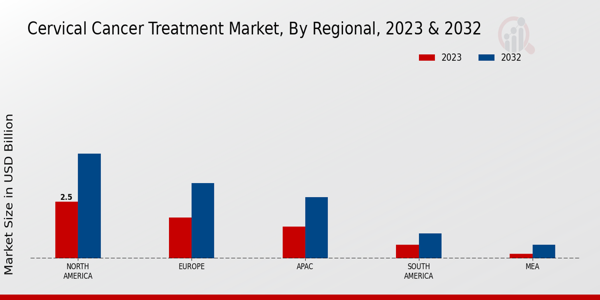Market Growth Projections
The Global Cervical Cancer Treatment Market Industry is projected to experience substantial growth over the coming years. With a market size of 6.96 USD Billion in 2024, it is anticipated to reach 15.2 USD Billion by 2035. This growth trajectory suggests a robust compound annual growth rate (CAGR) of 7.37% from 2025 to 2035. Factors contributing to this growth include advancements in treatment modalities, increased government funding, and rising awareness of cervical cancer prevention and treatment. As the market evolves, stakeholders are likely to focus on innovative solutions to meet the growing demand for effective cervical cancer therapies.
Growing Awareness and Education
The Global Cervical Cancer Treatment Market Industry benefits from the growing awareness and education surrounding cervical cancer. Public health campaigns and educational programs aimed at informing women about the risks and prevention strategies have gained momentum. Increased awareness of the importance of regular screenings and HPV vaccinations has led to earlier detection and treatment of cervical cancer. This shift in public perception is likely to drive demand for treatment options, as more women seek medical assistance. As educational initiatives continue to expand, the market is poised for growth, with a projected CAGR of 7.37% from 2025 to 2035, indicating a sustained focus on cervical cancer management.
Government Initiatives and Funding
Government initiatives and funding play a crucial role in shaping the Global Cervical Cancer Treatment Market Industry. Various health organizations and governments are increasingly investing in cervical cancer prevention and treatment programs. For example, initiatives aimed at increasing HPV vaccination rates and promoting regular screening are gaining traction. These efforts not only raise awareness but also facilitate access to necessary treatments. Furthermore, funding for research into new therapies and technologies is expected to bolster market growth. As governments prioritize women's health, the financial support for cervical cancer initiatives is likely to enhance treatment options and improve patient outcomes.
Advancements in Treatment Modalities
Innovations in treatment modalities significantly influence the Global Cervical Cancer Treatment Market Industry. The development of targeted therapies, immunotherapies, and personalized medicine has transformed the treatment landscape, offering patients more effective and less invasive options. For instance, the introduction of HPV vaccines has been pivotal in preventing cervical cancer, thereby reducing the overall incidence. Additionally, advancements in surgical techniques and radiation therapy have improved patient outcomes. As these technologies continue to evolve, they are likely to drive market growth, with projections indicating a market size of 15.2 USD Billion by 2035, reflecting the ongoing commitment to enhancing treatment efficacy.
Increasing Incidence of Cervical Cancer
The Global Cervical Cancer Treatment Market Industry experiences growth driven by the rising incidence of cervical cancer worldwide. According to the World Health Organization, cervical cancer remains a leading cause of cancer-related deaths among women, particularly in low- and middle-income countries. The increasing prevalence of human papillomavirus (HPV) infections, which are responsible for the majority of cervical cancer cases, further exacerbates this issue. As awareness of cervical cancer rises, the demand for effective treatment options is expected to increase, contributing to the market's expansion. In 2024, the market is projected to reach 6.96 USD Billion, highlighting the urgent need for innovative therapies.
Emerging Markets and Healthcare Infrastructure
Emerging markets present a significant opportunity for the Global Cervical Cancer Treatment Market Industry. Countries with developing healthcare infrastructure are increasingly recognizing the importance of addressing cervical cancer as a public health issue. Investments in healthcare facilities, access to screening and treatment, and the introduction of affordable therapies are likely to enhance market growth in these regions. As more women gain access to cervical cancer treatments, the overall market is expected to expand. The combination of rising healthcare expenditure and improved awareness in these markets could lead to a substantial increase in demand for cervical cancer treatments.






















